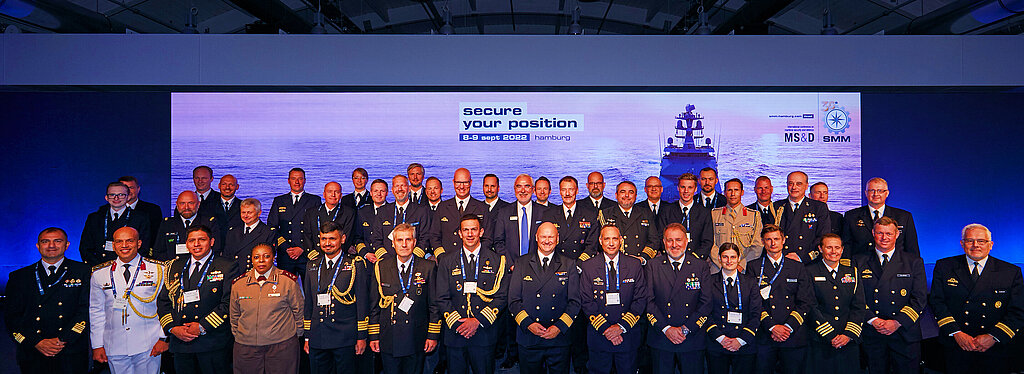Hamburg, 12-09-2022 – Times are changing at breathtaking speed: The last MS&D – held during SMM Digital 2021 – mainly focused on worries about the Covid-19 pandemic and its impact on the operational readiness of naval forces. By contrast, this year’s conference, featuring top-flight experts, was entirely dominated by the Russian invasion of Ukraine and the future defence strategy of NATO.
In his welcome address, Bernd Aufderheide, President and CEO of Hamburg Messe und Congress (HMC), made reference to the current political situation and the term “Zeitenwende”, or turning point, which was coined by Chancellor Olaf Scholz shortly after the beginning of the war. Scholz is the honorary patron of the 30th edition of SMM.
The MS&D itself saw a turning point of a different kind this year: For the last time Jan Wiedemann, co-publisher of Naval Forces magazine, a cooperation partner of SMM, hosted the two-day event as Chairman. Hamburg Messe CEO Aufderheide expressed his heartfelt thanks to Wiedemann for his many years of support: “Through his expertise and his close ties with key players in the international “naval community”, Mr Wiedemann has made a major contribution to the success of this conference series.”
In the ensuing keynote, Dr Martin Kröger, Managing Director of the German Shipowners Association, VDR, emphasized the indispensable role of merchant shipping, saying: “It not only keeps world trade going but also secures the supply of food and fuels to people around the globe.” Kröger used a voyage from Asia to Europe as an example to highlight the vulnerability of the maritime transport business by external events and the many threats along the way. Whether crew change issues caused by the Covid-19 pandemic or supply chain disruption, whether pirate attacks, cyber attacks targeting the on-board IT, or military conflicts such as the current Ukraine war: There is a long list of risks. Kröger’s conclusion: “We must meet these challenges by combining our forces.”
The dimensions of modern-day warfare
The first speaker, Egon Ramms,commented on what is most likely the greatest current challenge. A former Bundeswehr general and NATO commander, he presented a precise chronology of the Ukraine war from its first day, 24 February, up until the current situation. He warned that Russia might want to invade other former Soviet republics, saying the Kremlin might always resort to the pretence of “protecting Russian-speaking minorities”. Ramms made an urgent appeal to politicians to support Ukraine by political and military means and supply the heavy weapons the country needs: “The Ukrainian military is defending Western values and our freedom. It is important to help them reconquer the territories in the Donbass region occupied by Russia.”
The next speaker, Knut Baumann from thyssenkrupp Marine Systems, elaborated on a dangerous European “war inheritance”: Around 300,000 tonnes of ammunition from both World Wars are rotting on the bottom of the Baltic Sea alone, and 1.3 million additional tonnes in the North Sea. This poses a growing threat to underwater ecosystems, and consequently, to our food chain, he said. thyssenkrupp Marine Systems and its subsidiary, Atlas Elektronik want to help neutralise these hazardous ‘time bombs’. They use autonomous robotic underwater vehicles (RUVs) and a disposal platform where the decaying ammunition can be neutralised in an eco-friendly manner applying the hydrodestruction process.
Another threat of an entirely different kind lurks at the sea bottom, explained Patrick O‘Keeffe from the Institute for Security Policy at Kiel University (ISPK). “95 per cent of the global data traffic runs through submarine communication cables,” he said, describing recent observations of worrisome manoeuvres of Russian specialised vessels in the immediate vicinity of a subsea cable node off the Irish coast. “Technically it would be entirely possible to tap or manipulate the cables,” O’Keeffe said in his speech titled “Cybersecurity in naval operations”, in which he focused on the growing threat of cyber attacks amid the increasing integration of naval networks and intensifying data traffic.
Focus on maritime military hotspots
The second discussion panel explored current and potential future military hotspots outside Europe, especially in the Indo-Pacific region. For example, Taiwan, because of its direct access to the deep sea, is “of highest military interest to China”, said Dr Sarah Kirchberger, Head of the Department of Strategic Development in the Asia-Pacific Region at the ISPK . She underlined her remarks by describing the impressive expansion of the Chinese navy. According to Kirchberger, between 2014 and 2018 the PRC commissioned new tonnage equivalent to the entire Japanese naval fleet – which is the world’s fourth largest.
How the Japanese naval forces are ramping up their defensive capabilities to counter the growing threats from China as well as other neighbouring countries, such as Russia and North Korea, was the subject of the presentation by retired Captain Joachim Gutow, former German Defence Attaché to Tokyo, who explained: “Over the past years the Japanese have comprehensively modernised their military, acquiring fighter jets, helicopters and a fleet of submarines. Furthermore, they developed a new generation of unmanned vessels.” Japan’s intention is to provide more vigorous support to its allies in the Pacific region. This new military philosophy marks a break from Japan’s post-World War pacifist tradition.
Dr Ian Anthony from the Stockholm International Peace Research Institute (SIPRI) warned that the current political conflicts with Russia and China could extend all the way into the Arctic. The second panel discussion was concluded by Hanno Teuteberg, Rear Admiral and deputy Chief of the South-African Navy (rtd.), who laid out the maritime security architecture of the African continent. According to Teuteberg, the continent’s most important future initiative will be the African Integrated Maritime Strategy (AIMS 2050), a multinational charta signed by 34 African nations in 2016.
Shielding against attacks from sea, land and space
The second day of the conference began with the third panel discussion, titled “Littoral operations & harbour security”, which focused on maritime tasks at our own doorstep. In his speech, Captain (German Navy) Thorsten Mathesius from the NATO Centre of Excellence for Operations in Confined and Shallow Waters described the unique challenges associated with deployments in coastal waters and the protection of critical infrastructure. For example, he examined the question how one of northern Europe’s most important strategic waterways, the Kiel Canal, could be secured. This would primarily require close coordination between the military and the civilian administration, including various government agencies, as well as clear assignment of responsibilities and competences. Stephan Haisch, Rear Admiral and deputy commander of the German Maritime Forces Staff (DEU MARFOR), a military command and operational staff, based in Rostock, described how the Bundeswehr assumes responsibility within NATO and EU. DEU MARFOR, founded in 2016, plans, supports and conducts multinational maritime exercises and operations. In times of crisis, NATO or the EU, for example, can activate the staff as maritime headquarters to command multinational fleet units. For the German Navy this “lighthouse project” means entering a new territory. Haisch elaborated on the current status of the DEU MARFOR development and accreditation process as well as the challenges and opportunities of the new coordinating body. Josef Traxl from the eurotec group called for the creation of a centralised harbour protection office charged with managing all relevant activities. He outlined a complex defence scenario for ports using a combination of monitoring sensors, drones and unmanned craft.
The intriguing question whether and how hypersonic missiles could be intercepted – which approach their targets at more than ten times the speed of sound – was the subject of a presentation by Professor Dr Wolfgang Koch from Fraunhofer FKIE. He discussed potential countermeasures, such as deflecting the trajectory, or launching laser-guided counterattacks against the explosive plasma sheath surrounding the missile.
Torsten Feist from Naval Vessels Lürssen (NVL) presented an innovative mine sweeping and disposal concept based on a frigate featuring a non-magnetic steel hull, accompanied by unmanned surface and sub-surface craft, and equipped with sonar detection equipment and communication drones. This would allow a formation of ships to conduct minesweeping operations from a safe distance (so-called stand-off approach) or directly within a hazard zone (dedicated approach).
Fuel for future navies
Are climate-friendly fuels a realistic alternative for powering naval ships? A feasibility study presented by Andreas Junginger, Sales Navy & Governmental (SFNM), MAN Energy Solutions, came to a clear conclusion: Ammonia, methanol, SNG, bio-diesel and other alternatives fuels are no feasible options for the military today. At the present time their disadvantages weigh to heavily.
Another report addressing power management for naval vessels was that presented by Marko Bischoff, Senior Sales Manager – Naval Surface Vessels at Siemens Energy Marine. Advanced weapon and sensor systems are increasing the electric power demand on board naval ships, he pointed out. Powerful, smart and agile solutions are needed. Because of their reliability and high signal quality, Bischoff said, direct-current power supply units are best suited as primary energy sources on board.
The wide range of topics the MS&D is known to cover was completed by three speeches detailing how unmanned, remote-controlled systems, both on the water and in the air, will revolutionise future warfare. The first of these reports was delivered by Christian Rucker, Head of Business Development Security and Defence, General Atomics Europe, who presented the MQ-9B SeaGuardian, a remote-controlled unmanned air vehicle (UAV). The unit can be integrated into the defence strategy of national navies for purposes such as air surveillance, coastal defence, or submarine detection. “SeaGuardian can also be armed with high-precision weapons, and is capable of observing a sea area for 20 hours or more without interruption,” said Rucker.
The remote-controlled, unmanned surface vehicles (USVs) by Aris Shipyard are similarly versatile, said CEO OzganUtku Alanc. “Our systems reduce the risk of hazardous troop deployments. They can handle tasks no manned platform could be charged with.” Furthermore, he said, in peaceful times these USVs can be used in coastal protection scenarios, such as deterring and fighting criminal activities, or humanitarian missions to save lives or fight fires at sea.
Daniela Hildebrand, Head of Counter-UAS Solutions at ESG Elektroniksystem- und Logistik-GmbH, introduced an anti-drone defence system. Her company’s military defence equipment uses a wide array of surveillance systems, such as jammers, high-powered electric magnets, and defence drones. “Our GUARDIAN system identifies up to 80 per cent of hostile flying objects,” said Hildebrand.
The conclusion from all this: Unmanned armed craft are going to change future warfare significantly – which inevitably raises legal questions too. Both, UAV expert Rucker and USV engineer Alanc emphasized during the subsequent discussion that the question who can and should be held liable for the use of these systems has not been clarified to date. What is clear, however, is this: There will be plenty of topics to discuss at the next MS&D!
The next SMM will take place from 3 to 6 September 2024.


